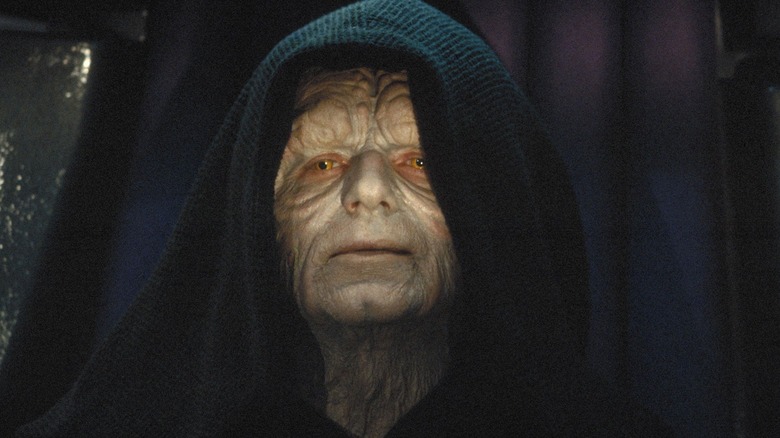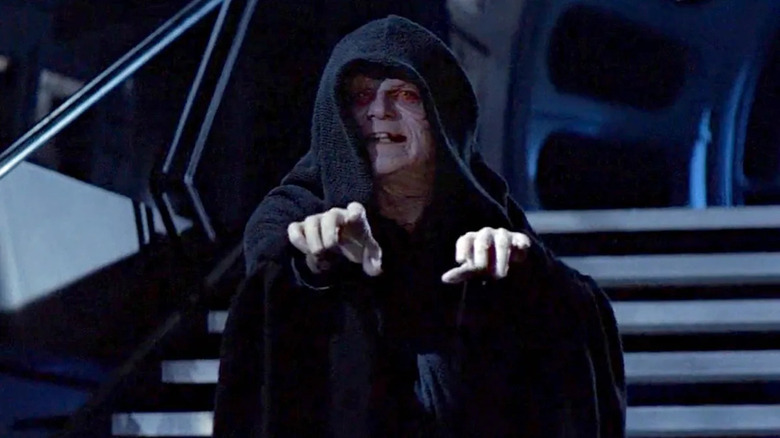Star Wars' Emperor Palpatine Had A Surprisingly Casual Outfit On Under His Robes
In 1977's "Star Wars: Episode IV — A New Hope," the character of Obi-Wan Kenobi (Alec Guinness) was introduced wearing lightweight, light-colored robes, outfitted with a loose, cloak-like hood. One might rightly assume that the robes were necessary for living on the desert planet of Tatooine, and that light, full-bodied robes were key for keeping the sun off his head and body. One doesn't want skintight black leather in the desert, no matter what the L.A. Goth kids might be unwisely wearing to Disneyland during the summer.
Later in the series, in 1983's "Star Wars: Episode VI — Return of the Jedi," fans would see the character of Emperor Palpatine (Ian McDiarmid) in person for the first time, and he, too, would be wearing dark robes. Palpatine's cloak, however, was more mysterious, serving to obscure the frail body and place face of the twisted warlock lord. The cloak-and-robe aesthetic for Jedi and for Sith was, by then, pretty firmly established, at least as a general costuming motif.
It wouldn't be until the release of "Star Wars: Episode I — The Phantom Menace" in 1999, set several decades before the original trilogy, that light brown robes were depicted as a Jedi's semi-official uniform. Jedi were an aloof cloister of monks that worked for the Old Republic and functioned as superpowered policemen. What one once assumed was Obi-Wan Kenobi's desert wear was actually his old cop outfit. Desert robes became Jedi robes. Audiences were able to tell who was a Sith, as they tended to wear creepy black cloaks.
As the grand poobah of creepy black cloaks, McDiarmid talked about his famed "Return of the Jedi" costume in a 1998 issue of Star Wars Insider Magazine. It seems that, however comfy those big black robes looked, McDiarmid was even more comfy underneath. He just wore a t-shirt.
Palpatine wore a t-shirt
A close look at Palpatine's cloak in "Return of the Jedi" reveals that it's made of terrycloth or some other equally heavy material. It wasn't flowy and light like the Jedi's desert robes. According to McDiarmid, the cloak was very hot, so he was grateful to be able to wear something more practical underneath:
"I think I was wearing a very dignified black outfit. I remember it quite well. It was sort of Japanese black trousers and a T-shirt. It was very cool, because the cloak itself was quite warm, so I was grateful about that."
McDiarmid played a large part in the climax of "Return of the Jedi" and had to rise from his black Imperial throne to hurl Force lightning at the film's hero, Luke Skywalker (Mark Hamill). It wasn't a role that required a lot of stunts or physical activity. Still, it couldn't have been comfortable underneath the cloak, not least of all while also wearing extensive facial prosthetics and contact lenses.
"The Phantom Menace" was released after that interview. The film revealed that a younger Palpatine served as a senator to his home planet, Naboo, while secretly operating as the Sith lord Darth Sidious. In 2005's "Star Wars: Episode III — Revenge of the Sith," Palpatine was struck by his own Force lightning, heavily scarring his face and eyes and giving him his appearance in "Return of the Jedi." It was during that film that he also began wearing his Sith cloak in public upon declaring himself Galactic Emperor.
Amusingly, McDiarmid said that the word "Palpatine" was pronounced with a long "I," which was also information re-litigated for "The Phantom Menace." Now it is pronounced "PAL-pa-teen."
The evolution of cloaks in Star Wars
Ever since "Revenge of the Sith," Palpatine and all Sith have been seen in black cloaks or capes. One simple fashion choice in 1983 visually informed the sci-fi franchise forever. Darth Maul (Ray Park) wore black clothes in "The Phantom Menace," as did Kylo Ren (Adam Driver) in 2015's "Star Wars: Episode VII — The Force Awakens." It seems that hiding one's face is also an important part of being a Sith, as many of them, when they're not hiding under cloaks, wear full face masks. The masks were inspired, quite clearly, by Darth Vader (David Prowse) in the original trilogy, although he wore the mask as a respirator and required it to breathe.
Like many details in "Star Wars," though, the mask took on additional significance with each revisitation. There was a time when Boba Fett wore a mask for unexplained reasons. Expanded universe lore imprinted additional significance to the helmet.
The same can be said of Jedi robes and Sith cloaks. They weren't always a uniform. Indeed, for many years, the Sith lived in the shadows, trying to hide their existence from the Jedi. One would think that having a signature look would be a tipoff. Also, Jedi robes are an unusual costume choice for a regal police force of psychic, laser sword-wielding monks. It seems like they should have more streamlined fighting outfits, if not robes that skewed more liturgical. Thanks to Obi-Wan, though, light-colored desert robes are now the norm.
We can only hope they've all been as comfy underneath those outfits as McDiarmid was underneath his.


